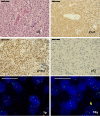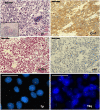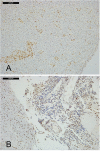Recurrent oligodendroglioma with changed 1p/19q status
- PMID: 35144313
- PMCID: PMC9546156
- DOI: 10.1111/neup.12789
Recurrent oligodendroglioma with changed 1p/19q status
Abstract
We report a case of oligodendroglioma that had consistent histopathological features as well as a distinct change in 1p/19q status in the second recurrence, after temozolomide chemotherapy and radiotherapy. The first tumor recurrence had oligodendroglial morphology, IDH1 R132H and TERT promoter mutations, and 1p/19q codeletion detected by fluorescent in situ hybridization (FISH). Copy number analysis, assessed by next-generation sequencing, confirmed 1p/19q codeletion, and disclosed loss of heterozygosity (LOH) of chromosomes 4 and 9 and chromosome 11 gain. The second recurrence featured not only oligodendroglial morphology but also the appearance of admixed multinucleated giant cells or neoplastic cells having oval nuclei and mitoses and showing microvascular proliferation; it maintained IDH1 R132H and TERT promoter mutations, acquired TP53 mutation, and showed 19q LOH, but disomic 1p, detected by FISH. Copy number analysis depicted LOH of chromosomes 3p, 13, and 19q, 1p partial deletion (1p chr1p34.2-p11), and gain of chromosomes 2p25.3-p24.1, 8q12.2-q24.3, and 11q13.3-q25. B-allele frequency analysis of polymorphic sites disclosed copy-neutral LOH at 1p36.33-p34.2, supporting the initial deletion of 1p, followed by reduplication of 1p36.33-p34.2 alone. These findings suggest that the two tumor recurrences might have originated from an initial neoplastic clone, featuring 1p/19q codeletion and IDH1 and TERT promoter mutations, and have independently acquired other copy number alterations. The reduplication of chromosome 1p might be the result of temozolomide treatment, and gave rise to false negative 1p deletion detected by FISH. The possibility of 1p copy-neutral LOH should be considered in recurrent oligodendrogliomas with altered 1p/19q status detected by FISH.
Keywords: H3K27me3; IDH; TP53; oligodendroglioma; tumor mutational burden.
© 2022 The Authors. Neuropathology published by John Wiley & Sons Australia, Ltd on behalf of Japanese Society of Neuropathology.
Figures




Similar articles
-
Loss of H3K27 trimethylation is frequent in IDH1-R132H but not in non-canonical IDH1/2 mutated and 1p/19q codeleted oligodendroglioma: a Japanese cohort study.Acta Neuropathol Commun. 2021 May 21;9(1):95. doi: 10.1186/s40478-021-01194-7. Acta Neuropathol Commun. 2021. PMID: 34020723 Free PMC article.
-
Comparative molecular analysis of primary and recurrent oligodendroglioma that acquired imbalanced 1p/19q codeletion and TP53 mutation: a case report.Acta Neurochir (Wien). 2020 Dec;162(12):3019-3024. doi: 10.1007/s00701-020-04514-3. Epub 2020 Aug 12. Acta Neurochir (Wien). 2020. PMID: 32785787
-
Morphologically, genetically and spatially mixed astrocytoma and oligodendroglioma; chronological acquisition of 1p/19q codeletion and CDKN2A deletion: a case report.Brain Tumor Pathol. 2023 Jan;40(1):26-34. doi: 10.1007/s10014-022-00448-z. Epub 2022 Dec 26. Brain Tumor Pathol. 2023. PMID: 36572828
-
Diagnostic accuracy of 1p/19q codeletion tests in oligodendroglioma: A comprehensive meta-analysis based on a Cochrane systematic review.Neuropathol Appl Neurobiol. 2022 Jun;48(4):e12790. doi: 10.1111/nan.12790. Epub 2022 Mar 3. Neuropathol Appl Neurobiol. 2022. PMID: 34958131 Free PMC article.
-
Molecular background of oligodendroglioma: 1p/19q, IDH, TERT, CIC and FUBP1.CNS Oncol. 2015;4(5):287-94. doi: 10.2217/cns.15.32. Epub 2015 Nov 6. CNS Oncol. 2015. PMID: 26545048 Free PMC article. Review.
Cited by
-
A single-arm phase 2 study of abemaciclib in adult patients with recurrent grade 3 oligodendroglioma.Neurooncol Adv. 2025 Jan 17;7(1):vdaf011. doi: 10.1093/noajnl/vdaf011. eCollection 2025 Jan-Dec. Neurooncol Adv. 2025. PMID: 39944054 Free PMC article.
-
IDH-mutant diffuse gliomas: tips and tricks in the era of genomic tumor classification.Histol Histopathol. 2023 Jul;38(7):739-753. doi: 10.14670/HH-18-582. Epub 2023 Jan 9. Histol Histopathol. 2023. PMID: 36651583 Review.
References
-
- Louis DN, Ohgaki H, Wisteler OD et al. WHO Classification of Tumors of the Central Nervous System. Lyon: IARC, 2016.
-
- Reuss DE, Sahm F, Schrimpf D et al. ATRX and IDH1‐R132H immunohistochemistry with subsequent copy number analysis and IDH sequencing as a basis for an “integrated” diagnostic approach for adult astrocytoma, oligodendroglioma and glioblastoma. Acta Neuropathol 2015; 129: 133–146. - PubMed
-
- van den Bent MJ, Brandes AA, Taphoorn MJ et al. Adjuvant procarbazine, lomustine, and vincristine chemotherapy in newly diagnosed anaplastic oligodendroglioma: Long‐term follow‐up of EORTC brain tumor group study 26951. J Clin Oncol 2013; 31: 344–350. - PubMed
Publication types
MeSH terms
Substances
LinkOut - more resources
Full Text Sources
Medical
Research Materials
Miscellaneous

